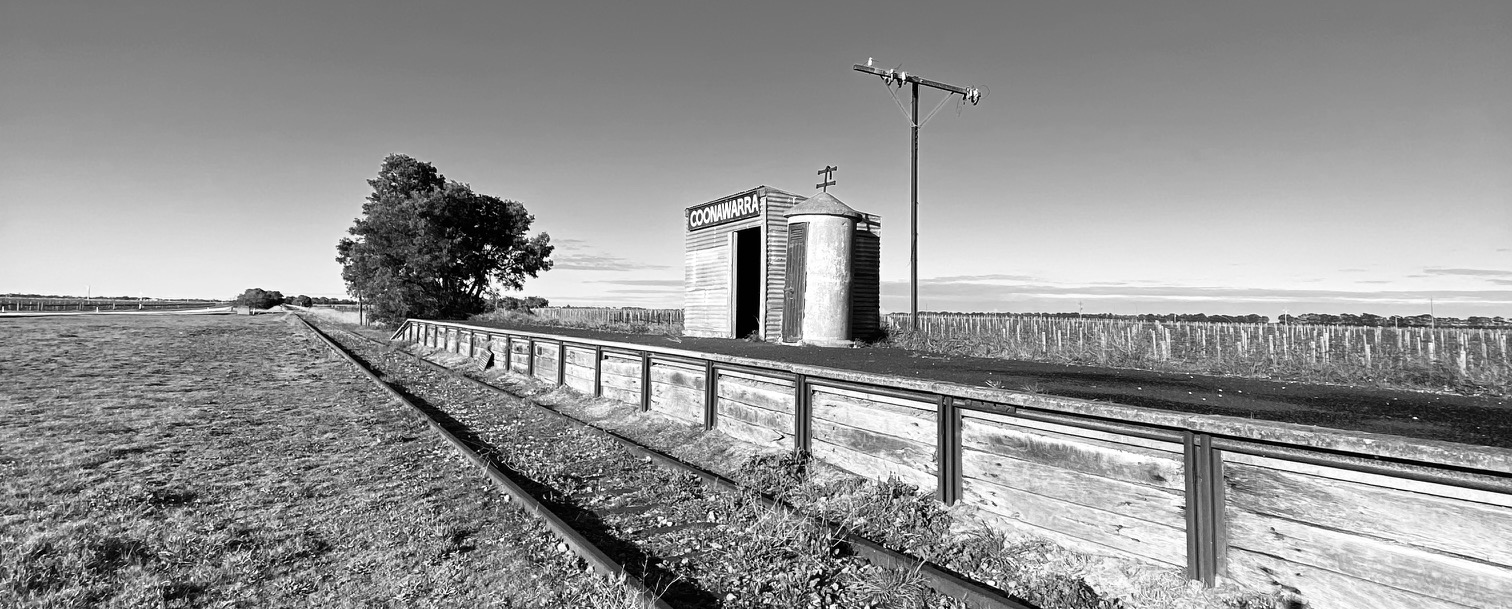
COONAWARRA – the region
Coonawarra is famously flat. In fact, it makes the Médoc look positively mountainous. Yet its special character lies just underground in the form of the famed terra rossa soil. Its red hue derives from the soil’s iron content but equally important is the permeable limestone that sits below which retains moisture and sustains the vines in very dry periods, ensuring that no supplementary irrigation is necessary.
Only central Coonawarra (meaning ‘wild honeysuckle’ in the indigenous language) enjoys this bank of terra rossa, a cigar-shaped strip of land that extends for 15km on a north-south axis yet is only one kilometre wide. The total area is barely 20 square kilometres in size.
The loamy soil drains readily into the porous limestone, helping with early budburst, although the downside of this is the risk of frosts which are frequently responsible for the partial or occasional complete loss of crop. The danger period starts towards the end of September and extends through to late November.
The shallowness of the topsoil means there is a finely balanced level of moisture and nutrients available to the vines through to the second half of the growing season and well into the cool, dry autumn. This cooler environment helps to slow down vegetative growth to a period of over 8 months, increasing the berry hang-time well into May. The result is Cabernet Sauvignon and Shiraz wines which display great structure and ageing potential.
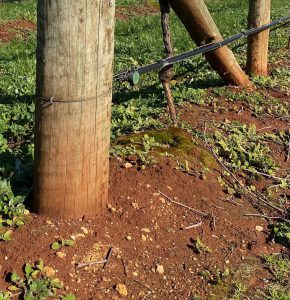
LOCATION
Coonawarra is the most southerly of all mainland Australia’s wine growing regions. Isolated, it’s located in the extreme south-east of South Australia, between the towns of Mount Gambier and Naracooorte. It’s just a short drive to the border with Victoria, yet a mammoth 428-kilometre trip to the state capital, Adelaide.
Sitting at 60 metres above sea level, the district is cool (certainly much cooler than Barossa), wet (annual rainfall is around 65cm) and, once off the terra rossa bench, it becomes marshy and the soils become noticeably different. Whilst vines are planted on the ‘black’ soils, these are often subject to waterlogging and over-cropping.
Temperatures are mild compared to the rest of the country due, primarily, to its low elevation and proximity to the sea. Its isolation and terra rossa soil give Coonawarra an added advantage of being phylloxera-free.
HISTORY
As a wine producing region, Coonawarra dates back to the late 1800s. It really began with two Scotsmen: William Wilson and John Riddoch. It was Wilson who first and unwittingly discovered its potential. He had travelled to Australia as a shepherd but, after a fortuitous gold strike at Ballarat, bought two acres in Penola, where his land was on the southern margin of the terra rossa bank. He planted fruit trees on the property and was amazed at how well they grew.
This drew the attention of John Riddoch. Born in Banffshire in 1826, he arrived in Victoria in 1852 with his parents and four brothers. They soon joined the quest for gold and, although they didn’t find their fortune digging, their entrepreneurial skills saw them opening a store to provide provisions to those who were.
In 1861, and after the gold had petered out, Riddoch moved with his family to Penola where he set to improve a 35,000-acre farm running 50,000 sheep. Locally, he became known as the Squire of Penola, living a lifestyle that was in keeping with the title.
The Riddoch-Wilson partnership was an unlikely one. The modest gardener and the Squire. Although neither could have fully appreciated the potential of what was to come, together they were to give birth to the Coonawarra as we know it today.
Around 1890, Riddoch founded the Coonawarra Fruit Colony, splitting some of his Yallum Estate into blocks of between 10 and 30 acres. Charging £10 per acre, he allowed settlers to repay loans over a 10-year period at a modest 5% interest. He also set an example by planting 250 acres of his own land with fruit trees and vines.
But the new settlers were not skilled vignerons. They were not even very good farmers and Riddoch’s grand plan never took account of this key to any future success. The fruit Colony fell into a depressed state. Many settlers walked off the land and those who stayed were insulted by the low prices they were being offered for their grapes. By 1900, the remaining growers showed a final piece of defiance when, refusing to sell their crop, they turned pigs into the vineyards to feast on that year’s harvest.
So, the district of Coonawarra has had a somewhat chequered history, with the Australian wine consumer only really becoming aware of it as a wine producing region following the purchase of Chateau Comaum by David Wynn (of the eponymously named winery) in 1951 with Wynn inheriting 67 hectares of Cabernet Sauvignon and 60 hectares of Hermitage (Shiraz) which were already planted.
BRAND AND SONS
The Brand family might well be considered Coonawarra royalty.
When David Wynn purchased what is now Wynns Coonawarra Estate in 1951, he was beaten to entering the district by one year, after Eric Brand and his wife, Nancy Redman (sister of Owen) acquired what was to become known as Brands Laira (Laira being named after a boat). The couple became custodians of two hectares of Shiraz vines originally planted in 1893 by Captain Henry Stentiford, one of John Riddoch’s original tenant settlers.
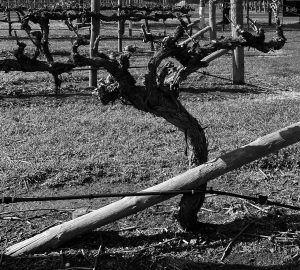 From 1950 through to 1965, Eric (originally a baker from the Riverland, until he fell in love with the Redman girl and relocated), developed the 24-hectare estate, working as a ‘blocker’, the name given to Coonawarra landholders who sold off their grapes to other wineries within the region.
From 1950 through to 1965, Eric (originally a baker from the Riverland, until he fell in love with the Redman girl and relocated), developed the 24-hectare estate, working as a ‘blocker’, the name given to Coonawarra landholders who sold off their grapes to other wineries within the region.
Then, in 1966, armed with an antique basket press, must pump and four concrete fermenters and blessed with the best weather conditions of the decade, Eric set about producing his first ever vintage under the Brands Laira name.
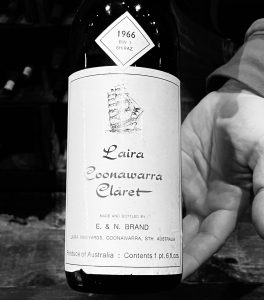 The winery existed under the ownership of the Brand’s until, like many family-owned businesses feeling the pinch at the back end of the 1980s, elected to sell off the property to McWilliams who, at that time were also family owned and considered to be an ideal partner. That was in 1995, although the family did retain several of the existing vineyards.
The winery existed under the ownership of the Brand’s until, like many family-owned businesses feeling the pinch at the back end of the 1980s, elected to sell off the property to McWilliams who, at that time were also family owned and considered to be an ideal partner. That was in 1995, although the family did retain several of the existing vineyards.
McWilliams extended their holding in the area from around 35 to 258ha, although very little of that additional production ended up under the Brands Laira label. Under some financial pressure themselves, McWilliams off-loaded the business as a going concern to Castella (home of ‘Yellowtail’) in late 2015.
Going back to Eric and Nancy. The couple had two sons: Jim and Bill, who after the sale to McWilliams set about establishing new vineyards. Combined, the two families own around 200 hectares, making them one of the most significant ‘blockers’ in the region, selling off grapes to the likes of Treasury Wine Estates, proprietors of Wynns, Penfolds, Seppelt and Wolf Blass (to name but a few).
After the 1995 sale, the link with McWilliams remained, since Jim took a position as head winemaker at Brands Laira, whilst Bill became the viticulturist. Bill was succeeded by his son, Trent, who became vineyard manager on Bill’s retirement.
Sadly, Jim Brand, died after a long battle with cancer in 2005. He was 52 years old.
Jim and his wife, Jo (who still lives in downtown Coonawarra) had one son named Sam. Born in 1977, Sam studied wine marketing at Roseworthy College before also enjoying a career with McWilliams, working for them as sales manager covering both South Australia and Northern Territory until 2012.
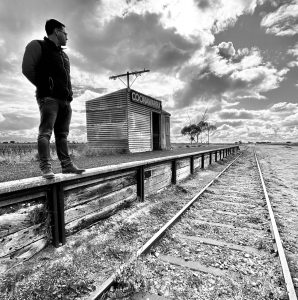
Now, this is where we bring the story up to date…
Sam has since devoted himself to re-establishing the Brand name as a formidable force in the Coonawarra wine scene, officially launching Brand and Sons in 2012. It was the first time in over two decades that the family had commercially put their own name to a label.
The project is very much a tribute not only to his own father but to the legacy of the Brand family within the region with each new release telling its own story.
Sam says ‘Dad was absolutely committed to his role at Brands Laira and was highly regarded in the industry, not only for his success on the show circuit, but for his generous and friendly nature. He was very proud of his family and our heritage, and it means a lot to be able to fulfill his dream by releasing wines under his name. Small batches of premium wines, made in the heart of Coonawarra.’
‘I grew up in Coonawarra, which was a unique experience. As kids, we were sticking labels on bottles and now I’m doing what we did in the past, which is making wine’.
At present, there is no cellar, with Sam using facilities at Bellweather Winery and at Jack Estate, both in the heart of the district. In December 2022, Sam was joined by winemaker, Peter Weinberg. Peter had been assistant under Jim at Brands Laira and had taken on the role of head winemaker after Jim’s untimely death.
The Brand story seems to have come full circle…
THE WINES
‘Baker’s Run’ Coonawarra Cabernet Sauvignon
Returning from war, Eric Brand took up his trade as a baker in the Riverland of South Australia. But times were tough in the local community, and many couldn’t pay cash but traded with local produce of fresh fruit and vegetables in return for their daily bread. Unfortunately, fresh fruit doesn’t pay for flour and eventually the mill stopped its supply. Using the last of his dough, Eric baked his final batch of loaves and delivered his last run, before departing for a new life in Coonawarra.
Fruit hand selected from the first 25 rows of the ‘Yates’ vineyard located in the ‘mid-west’ of Coonawarra. Crushed into stainless steel tanks with 10% of the juice run-off to help concentration. A 24-hour maceration before a seven-day fermentation. Transferred to 25% new French and American oak and aged for 18 months. Vinified at Brands Laira.
‘Fire and Ice’ Coonawarra Shiraz
In the early 1960s, a week of sub-zero temperatures forced the locals to employ ‘frost pots’ in the vineyard to keep the chill from the young vines. Each night was a battle, with the family working every night to save the vines and their livelihood. The clear sky warned of the battle to come and in the dead of night the temperature dropped, a frost descending. A glow filled the sky as the pots were lit and the vineyards were ablaze with the warmth of the fires pushing back against the cold. So was the battle of Fire and Ice.
A blend of Glenroy (northern Coonawarra) and central Coonawarra fruit. Machine picked. Crushed into stainless steel tanks with 10% of the juice run-off to help concentration. A 24-hour maceration before a seven-day fermentation. Transferred to 25% new French and American oak and aged for 18 months.
‘Night Owls’ Coonawarra Shiraz Malbec
A far cry from the big city, the local community meets every Friday night at ‘The Coonawarra Club’ to share a meal, a drink and tales of the week that was. If visiting the club in the late 1960s, you may have been lucky enough to hear ‘The Night Owls’ play. Led by Eric Brand on Piano and Don Redman on Sax, the band played jazzy tunes to the local hall, demonstrating without doubt, that they were equally adept at keeping in tune as they were at making wine. ‘The Night Owls’ were well known for years to come as the band to hire for keeping the people dancing and the night young.
Glenroy Shiraz and Malbec from Wrattonbully. Machine harvested and aged in a combination of American, French and Hungarian oak.
‘Last Sunday Drive’ Coonawarra Cabernet Franc
Summer ’73 and a rusty bulldozer rumbled into life, signalling the end of ‘The colony’ and a distinct lowering of the Coonawarra skyline. For almost 90 years, families had flocked to Coonawarra to collect bountiful fruits which grew in orchards on the famed terra rossa soil. But as the demand for wine grew, the last of the fruit trees were felled on a summer’s day in ’73. The end of an era, the last of the blockers and the last Sunday drive.
From the ‘Yates’ vineyard and two other vineyards in Coonawarra. Both hand and machine picked. The wine enjoys around 20% new oak.
‘Silent Partner’ Coonawarra Cabernet Sauvignon
Jim Brand was born into the third generation of an Australian winemaking legacy with his family name synonymous with the world-renowned Coonawarra region. His life was dedicated to producing iconic wines from the family vineyards, with a passion and sincerity evident in every glass. This passion spoke much louder than his words, his influence felt long after his time passed.
In honour of Sam’s late father. The first release was from the 2005 vintage, the year that Jim Brand died. A combination of hand and machine picked fruit, aged in mostly French and Hungarian oak.
www.brandandsons.com.au
| Untold BakersRun | pack shot | fiche 2019 |
| Untold Fire&Ice | pack shot | fiche 2019 |
| Untold Last Sunday Drive | pack shot | fiche 2019 |
| Untold NightOwls | pack shot | fiche 2019 |
| Old Town | pack shot | fiche 2021 |
| Jim Brand The Remnants | pack shot | fiche 2021 |
| Jim Brand SilentPartner | pack shot | fiche 2018 |